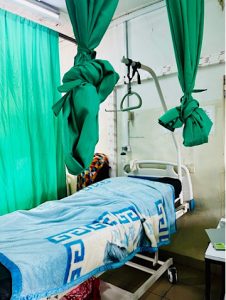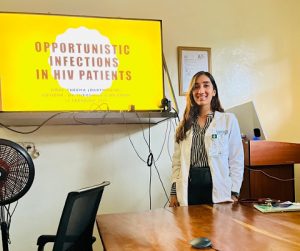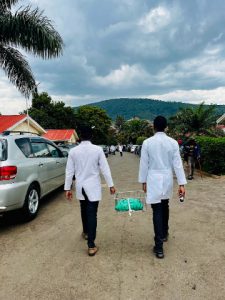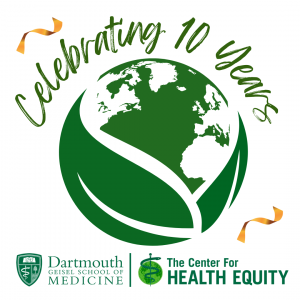All photos courtesy of Amal Cheema
Amal Cheema MED’24, recent graduate of Dartmouth’s Geisel School of Medicine, reflects on the six weeks she spent completing a global health elective in January-February 2024 at Rwanda’s main teaching hospital Centre Hospitalier Universitaire de Kigali (CHUK).

“I will always be grateful for how much they welcomed me into their cohort and for all they have taught me.”
- Amal Cheema MED’24

At CHUK, the medical wards are split into separate buildings, connected by verandas and surrounded by grassy lawns – patients can be found picnicking outside with their families and enjoying the cool mountain weather. Our days start at 8 am with a morning case report or physical exam session. Robed in white coats, residents and students filed into the conference room, where learning begins. Having spent most of my days in the inpatient wards, the first few hours involve rounding on patients, as well as working with nurses, consultants, and pharmacy students. Most days, I work with another Rwandan medical student, dividing the care of the eight patients between us and writing our notes in the standard Subjective-Objective-Assessment-Plan (SOAP) format. History-taking is a collaborative effort, and I primarily rely on what is told to me or handwritten in the patient binders, given my lack of fluency in Kinyarwanda. When asked to take histories independently with French-speaking Burundi or Congolese patients or translate documents, I acknowledge my lack of fluency as I’m not certified in medical French and learn what I can. My peers taught me enough Kinyarwanda to do the physical exam independently. The assessment and plan are fully reviewed and supervised by a resident and attending.

Each ward has about three or four blocks of eight patients, whose beds are lined in pods of four. Each bed has long green drapes hanging from the ceiling to separate patients and provide privacy. The bed has white sheets and a thick wool blanket. Some wards try to separate women or men among the blocks. Two wards, are for low-income patients while two other wards are reserved for VIPs and VVIPs. There is a separate ward for patients diagnosed with an infectious disease, an important infection control practice. I mostly worked in Ward #3, where there was a beautiful community-like camaraderie among the patients and caregivers. They look after each other, share meals, and care for children who often share the inpatient bed with their admitted mothers. Most patients are 15 and older, but there is a fair share of younger and older people. Common presentations in the wards include HIV and related opportunistic infections, tuberculosis (pulmonary or extrapulmonary), undifferentiated sepsis, chronic obstructive pulmonary disease and severe bronchiectasis, malaria, diabetes and related complications, and liver failure. Cancer of the breast, prostate, intestines, liver, and lung were also among the diagnoses. Other conditions include aplastic anemia (of unknown cause), gastroenteritis, typhoid fever, pneumonia and bronchitis, chronic kidney disease/end-stage renal disease, nephrotic syndrome, heart failure, and congenital heart disease, as well as more uncommon conditions such as chronic inflammatory demyelinating polyradiculoneuropathy.

Spending some time in the Emergency Department (ED), I also saw patients with severe burns, trauma from motorcycle accidents, cerebral malaria, obstructive nephropathy, and even hepatocellular carcinoma (HCC) without a history of alcohol use or hepatitis – which raised concern for aflatoxin-induced HCC. Working in this setting, I had to learn quickly about the different epidemiology of diseases, adding malaria, typhoid, hepatitis, HIV, and side effects of herbal medicine to most differentials. Likewise, I deeply appreciated learning from medical and pharmacy students about the different approaches to diagnosis and management. I was told that many patients on the community-based health insurance pay about 10% of any medication, lab, imaging, or procedure up-front. We were very careful to order specific labs and follow a sequential approach to diagnostics -- an x-ray before a CT scan and adding only one to three medications at a time. Patients were less likely to be on medications that we order reflexively in the U.S., such as proton-pump inhibitors, painkillers, and stool regimens. While antibiotics are commonly prescribed, the broad-spectrum antibiotics which we frequently order in the U.S., were less commonly used.

While in the ED, I wrote admission notes, progress notes, consults, and prescriptions under supervision. I observed a few procedures, like taps to remove ascitic fluid from the abdomen, chest tube placements, A-line placements, and lumbar punctures. I helped take EKGs and participated in resuscitations. On other days, I observed endoscopies performed by the Gastroenterology service, attended the rheumatic heart disease clinic, and shadowed the oncology team at King Faisal Hospital (KFH), the large private hospital in Kigali. I was told that KFH has the only cardiac catheterization lab. It also has a different supply chain that allows a broader range of drugs and procedures. Still, many patients at CHUK and KFH go to Turkey or India to get essential procedures like cardiac surgery, which sometimes is funded by the government, depending on the referral board.
At CHUK, across the wards and clinics, I was impressed by how much of the work is done by Rwandan medical students, who performed at the level of sub-interns managing eight patients, as well as the residents, who often oversaw entire wards at a time. The medical students and I would often talk about the inequitable and unfair challenges that came with caring for patients in this setting.
I sincerely appreciated our afternoon teaching sessions, where the medical students and the residents taught each other about key clinical topics. We often discussed how many of the guidelines or recommendations were US-specific. We were critical of the demographical limitations of the studies and how certain recommendations could not be currently applied in resource-limited settings.

Over the six weeks, the Rwandan medical students and I became quite close, sharing personal stories and meals, spending time outside of the hospital, and even having inside jokes. I got looped into the teaching schedule and taught about nephritic syndromes and HIV opportunistic infections. In our changing room, I’d teach physical exam techniques, edit presentations, and discuss research projects. We also had important and difficult discussions about abortion, the legacy of the genocide, and socioeconomic divides.
Off the wards, I explored much of Kigali, throwing pottery and learning how to cook Rwandese cuisine. On the weekends, my friends and I visited the national parks. I interned in Kigali in the summer of 2016 as a volunteer health financing analyst at the Clinton Health Access Initiative; I was elated to reunite with old friends and see how much the country and healthcare system has changed. I will miss working with my medical student friends and CHUK colleagues, though we still communicate via WhatsApp. I will always be grateful for how much they welcomed me into their cohort and for all they have taught me. I am deeply thankful to my Rwandan colleagues and the Geisel’s Center for Global Health Equity for the opportunity, and will carry forward important lessons of global health equity into my career as a physician.
Murakoze cyane! (Thank you very much!)

